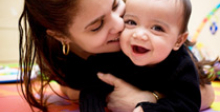Internal mini form
Contact Us Today
One would think abuse can be easily spotted, but unfortunately, the signs that a person is being mistreated are often difficult to detect. Understanding what abuse is and how to detect it, however, is the first step towards prevention.
What are the signs of abuse?
To cause physical harm to someone else is most definitely abuse; it’s a fact that most people understand.
What individuals may not immediately grasp is that abuse goes far beyond physical violence. There are actions that are assaultive on a person’s emotions and his or her spirit that, while most people would consider these actions cruel, many would hesitate to call them abusive. These actions are just as harmful to people with disabilities as acts of violence; the wounds are equally painful and its aftermath can be just as destructive.
Abuse of all incarnations is preventable. When a person abuses another, it’s actionable. Stopping abuse, however, requires that those in a position to act recognize what’s taking place. This allows them to right a profound wrong that is occurring in the life of a vulnerable person.
What are some of the actions that are indicative of abuse?
There are many actions that constitute abuse. The most obvious is physical abuse because, in many cases, it causes injury to a person or compromises his or her health. More difficult to detect is abuse that is verbal; things said that are meant to upset another individual, intimidate them, or force them into situations that are harmful or destructive are considered abusive.
Additionally, there are situations that are considered abusive that can bring about other problems for victims. Financial abuse, for instance, can bring about a situation that removes a person’s ability to pay for life necessities, or live independently.
The most common types of abuse are:
- Physical abuse – The most noticeable for of abuse, physical abuse can take place in the home, at school, or in a residential setting. The definition of physical abuse is any physical act that brings harm, discomfort or injury to another person. Further, acts of domestic violence, denying food or medical attention, failure to provide access to medical care, and assaultive acts such as beating, pinching, choking, chaining, force feeding, shoving, or otherwise inflicting pain on an individual.
When a person is being physically abused, the signs are easy to detect if a caring person has access to the person who is in this heartbreaking situation. Often, caregivers – or even the person that is being abused – may offer explanations as to why an injury exists. But if injuries are frequent, or begin after a new caregiver or provision of care is instituted, it deserves a second look. This is especially true if an injury seems incompatible with a person’s known activities and abilities.
The signs of physical abuse include:
- Bruises
- Cuts or punctures
- Burns
- Sprains
- Bone fractures
- Internal injuries
- Malnutrition, disease
- Emotional abuse, neglect – Emotional abuse and neglect occurs when a person’s basic physical and psychological needs are not met, to the point of harming his or her well-being and health. It can take the form of a caregiver or authority’s overt acts, such as making hurtful and harmful comments or threats, or ignoring a person’s medical needs. Both of these acts place a person – especially if he or she has a severe disability – in danger.
- Verbal abuse – The hallmarks of verbal abuse are statements that bring emotional pain, fear, suffering, anguish, discomfort or distress to a person. These comments can include name-calling, inappropriate or humiliating, comments, threats, and other statements intended to intimidate someone else. In a setting that involves a caregiver and a child or vulnerable adult, these comments often include those that indicate that insinuate bad things will take place if the victim does not accept mistreatment. When this occurs, it erodes a person’s self-confidence.
Signs of verbal and emotional abuse can be difficult to detect. Because there are few physical signs, it’s necessary that friends and relatives pay attention to subtle changes in a person’s attitude or personality.
Victims of verbal and emotional abuse undergo changes physically and psychologically that are detectable if a person is looking for the right indicators. Sometimes, people will have ups and downs that are not indicative of abuse. However, as with physical abuse, if those changes are continual or are out of character, it might be time to investigate.
The signs of verbal and emotional abuse include:
- Abrupt changes in attitude, demeanor
- Heightened sense of fear
- Withdrawal from social activities
- Loss of self-esteem
- Violent behavior, acting out
- Sleep disturbances
- Constant crying, emotional responses
The signs of neglect include:
-
- Unkempt personal appearance
- Unclean living environment
- Unwashed clothes
- Unexplained weight loss
- Skin rashes and sores
- Lice
- Malnutrition or dehydration
- Poor skin conditions
- Constant infections
- Substance abuse – Medications are often an essential component of a person’s medical treatment, but if drugs intended to help a person are misused, it presents a number of problems. Nonconsensual overuse of drugs can cause a medical emergency; an overdose or toxicity. Drugs can also impede a person’s ability to act of their own volition, or explain to another person that he or she is being mistreated.
- Sexual abuse – Non-consensual sexual behavior that takes place between a child or vulnerable adult and a caregiver or authority figure is considered abusive. Often, a person with intellectual disabilities will be unable to make an informed choice. Sexual behavior that includes a person that is below the age of consent is also considered abusive. Often, children and adults are drawn into such a relationship when they are under duress, or through coercion. Forms of sexual abuse include sexually-oriented comments, harassment, exposing one’s body or asking another to expose his or her body, forcing someone to take part in sexual activity against his or her will, up to and including sexual intercourse.
Sexual abuse also has some very specific signs that exclusive to this form of mistreatment, including:- Unexplained bleeding
- Discomfort in the abdominal region
- Social diseases, infections
- Irritated genitals
- Difficult walking or sitting
- Aversion to physical touch
- Hypersexual behavior
- Sudden fear of situations, specific people
- Emotional withdrawal
- Abandonment – When a person completely abandons the social, physical and medical needs of a person in their charge, it’s considered abandonment. The danger of abandonment for anyone with medical needs is that conditions can evolve to the point of being life-threatening. In an emotional sense, abandonment sends a message to an individual that his or her needs do not matter. It fosters a profound sense of loneliness and helplessness. Actions that constitute abuse include desertion, deprivation of medical attention, physical neglect, denying a person access to basic self-care, failure to provide nutrition, disallowing a person to practice religion, or failure to interact with others.
- Wrongful restraint – Restraining a person in medical or institutional settings is sometimes necessary for his or her personal safety. For example, if a person is receiving a specific medical treatment that requires them to remain still. But restraining someone for extended periods of time is unnecessary and abusive. Facilities should have adequate personnel to supervise residents; people should never be restrained because another person cannot supervise them. It’s also abusive to restrain a person if a caregiver has to leave a facility.
- Financial abuse – People with disabilities often have money, possessions and assets that are their own. When there is a caregiver in play, he or she should always make sure a person has access to his or her resources. It’s abusive for a person to misuse another person’s monies or government benefits, or use that person’s resources for their own ends. It’s not only abusive, it’s also an act of fraud. Monies and resources are provided to people with disabilities to ensure they receive care and support; if someone is unaware that his or her monies are being used for someone else’s benefit is abusive.
- Isolation – Depriving a person of interacting with friends or family members is dangerous because the more people that are involved in a person’s life, he or she may feel more secure. If a person that is not directly involved in the care of a person, he or she can assess how that person is being cared for, and sound an alarm of any suspicious activity. Seclusion that is involuntary allows abuse to continue unchecked and unabated – which is never a good situation for a person that depends on someone else for care.
Abuse
It’s shocking to think that there are people who would harm anyone, much less someone with special needs. Sadly, though, people with special needs can be vulnerable to such treatment at home, in school, at work and in public. There are, however, some particular safeguards people can implement that reduce the likelihood of mistreatment or harm. About Abuse
About Abuse
Ways in which to combat abuse

Disability Organizations
People tend to think about disability in terms of limits placed on a person’s physical, mental, social or developmental ability to function. Once people move past myths and perceptions about disability, they learn that it’s more about a person’s ability to compensate for special needs than it is about not being able to complete tasks in a predictable manner. Disability advocacy is about furthering equal opportunity for inclusion, accessibility and participation for all.
Learn more
About Disability
- Disability Etiquette
- People First Language
- Disability and Government Assistance
- Disability Advocacy Organizations
- Amnesty International
- World institute on Disability
- Administration on Intellectual and Developmental Disabilities
- American Association on Intellectual and Developmental Disabilities
- American Association of People with Disabilities
- National Association of Councils on Developmental Disabilities
- National Center on Birth Defects and Developmental Disabilities
- National Institute on Disability and Rehabilitation Research
- National Organization on Disability
- TASH
- Disability Policy Organizations
- European Disability Forum
- United Nations Enable
- World Health Organization – Disabilities an Rehabilitation
- Administration on Intellectual and Developmental Disabilities
- National Association of State Directors of Developmental Disabilities Service
- National Council on Disability
- United States International Council on Disabilities
- Disability Legislation









